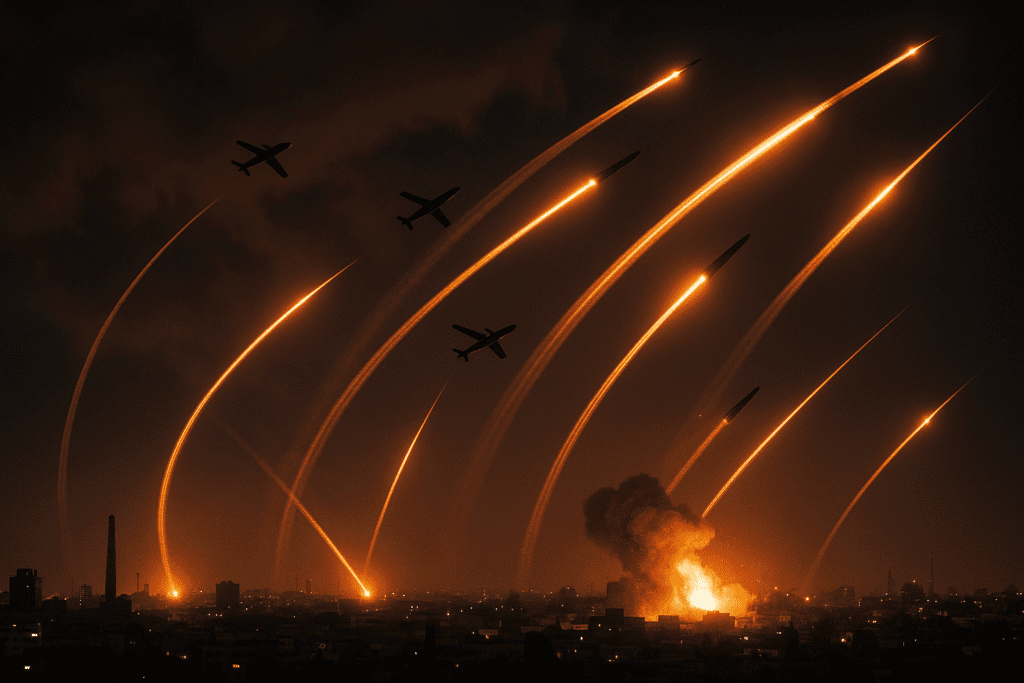A Historic Assault on Israel
On April 13, 2024, Iran launched a coordinated and unprecedented military attack on Israel, marking a significant escalation in the already tense relations between the two countries. The assault, dubbed Operation Iron Shield, involved an overwhelming barrage of over 170 drones, more than 30 cruise missiles, and over 120 ballistic missiles. This marked the largest and most complex military engagement between Iran and Israel in decades, pushing the conflict to new and alarming levels.
The attack was a dramatic shift in the region’s security dynamics, with Iran directly targeting key Israeli infrastructure. While the Israel Defense Forces (IDF) deployed its advanced air defense systems, with help from U.S., British, French, and Jordanian forces, to intercept the incoming projectiles, the sheer scale of the assault presented a significant challenge. Israeli defense systems intercepted approximately 99% of the drones and missiles, preventing the majority of the attack from reaching its targets. Despite these efforts, at least nine Iranian missiles successfully struck two Israeli airbases, causing minor damage to equipment but no significant casualties at the sites.
Casualties and Damage
The attack resulted in injuries to at least 32 individuals, including a 7-year-old girl, highlighting the indiscriminate nature of the assault. While the missile strikes caused only limited physical damage due to the successful interception of most projectiles, the psychological and political impact was substantial. The assault was a clear attempt by Iran to directly challenge Israel’s air superiority and security infrastructure, marking an escalation from previous proxy confrontations in the region.
This attack comes at a time of heightened regional tensions, with analysts warning that Iran’s actions could serve as a precursor to a broader regional conflict. Many feared that this marked a new phase in Iran-Israel hostilities, with the potential for direct military engagement between the two countries, which have long been in opposition on various fronts, including nuclear development, influence in Syria, and the broader Middle East balance of power.
International Condemnation and Reactions
The scale and intensity of the attack drew widespread international condemnation, with world leaders expressing shock and concern over Iran’s escalation. The United States, European Union, and other global powers condemned the missile and drone assault, calling it a provocative and dangerous escalation. Israel’s allies, including the U.S., which has long been a close security partner, reiterated their commitment to Israel’s defense and security.
While the United States and European countries expressed strong support for Israel’s right to defend itself, the attack has raised fears about the potential for further destabilization in the region. The UN Security Council convened emergency sessions to discuss the situation, urging all parties to avoid further escalation and engage in diplomatic efforts to de-escalate tensions.
Iran’s Motives and the Broader Regional Implications
Iran’s motivations behind the attack remain a subject of intense speculation. Some analysts suggest that the strike was a show of force in response to ongoing tensions in the region, particularly regarding Israel’s activities in Syria and its relationship with the U.S. and its Arab allies. Others believe that Iran may be seeking to assert itself as the dominant power in the region, especially in light of its expanding influence over various militias and proxy groups in Iraq, Syria, and Lebanon.
This attack, while limited in terms of immediate casualties, has far-reaching implications. The use of a massive combination of drones, missiles, and cruise missiles signals a growing reliance by state actors on asymmetric warfare and advanced technologies, potentially shifting the nature of conflict in the region. Analysts warn that Iran’s increased use of military force could prompt further retaliatory actions from Israel, especially if it views this as a challenge to its deterrence capabilities.
The Road Ahead: Escalation or Diplomacy?
The attack has pushed the region closer to the edge of a broader conflict. While both Israel and Iran have historically avoided direct, large-scale military conflict, the latest escalation has raised the stakes. Israel’s response will likely include further airstrikes on Iranian targets, both in Syria and potentially within Iran itself, as part of its strategy to neutralize Iranian threats.
At the same time, international diplomatic efforts will intensify to prevent the situation from spiraling out of control. Pressure will be placed on Iran to de-escalate, with the hope that diplomatic channels will prevent further military engagements. However, the situation remains volatile, and with the involvement of various regional and global powers, the potential for a larger, multi-front conflict looms large.
The unfolding events following Operation Iron Shield are likely to have profound and lasting effects on the geopolitical landscape of the Middle East, challenging existing alliances, influencing global oil markets, and shaping international diplomacy for years to come.
